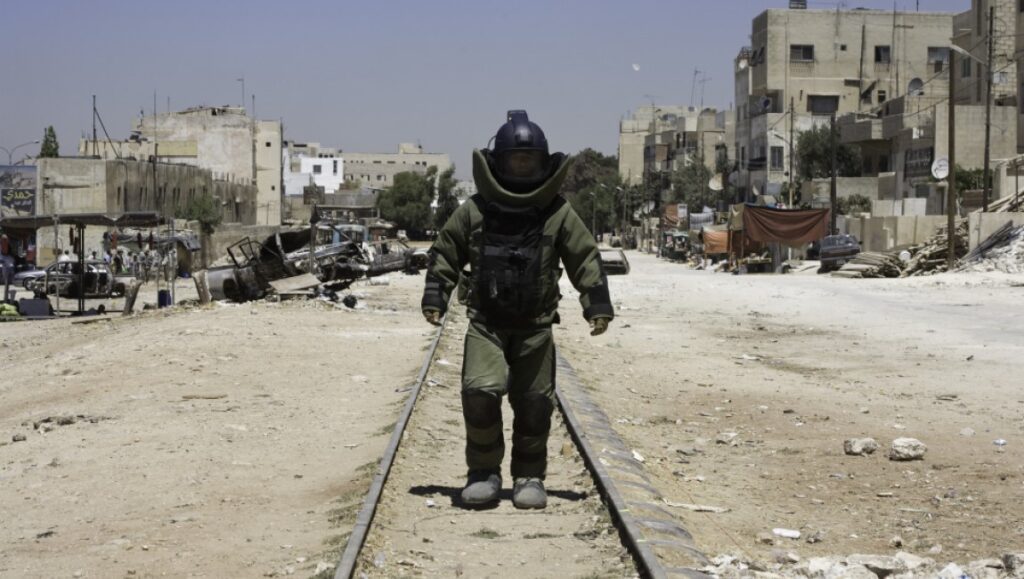Three American soldiers pace cautiously around a cluster of bombs in an Iraqi village as children from balconies and storekeepers from street-level doorways follow their every move. Tension builds throughout the opening scene of Kathryn Bigelow’s gut punch of a war film, The Hurt Locker, stemming here from both the impending detonation and from the threat the many villagers pose, each possibly concealing a detonator and just waiting for the Americans to get close enough to set it off. There are certainly more subtle ways to establish suspense than by introducing a bomb in the first sequence of a film, but, as evidenced from the subsequent explosion and brilliant visual collage of rust scraped from a car’s body and sand blowing sky high like a geyser, Bigelow means to heat things up quickly and shake you. The abrasiveness of the Point Break auteur’s latest may be its legacy, but there’s still a lot more depth here than in one of Michael Bay’s CGI’d-to-hell, soul-sucking demolition derbies.
In Hurt Locker, we’re shown a humanity representative of American-bred competition and easily agitated tempers, of loyalty to ones brothers and their country, and of fear, the kind spurred by living in a nightmare conflict like Iraq. It’s the open-wound vulnerability of Bigelow’s characterizations, seeping through layers of macho posturing and bulging muscle, that gives her film its beating heart, but it’s both the filmmaker’s willingness to avoid sentimental manipulation and the control she wields over her brawny aesthetic — the brutal poetry of her image sequencing and complementing intensity of her intricate sound design — that gives The Hurt Locker its quickening pulse.
Anthony Mackie (who stole the show in 2006’s otherwise overrated Half Nelson) and Brian Geraghty play soldiers in a three-man unit tasked with disarming bombs daily under increasingly hostile and dangerous circumstances (one of the film’s most searing visuals: a soldier tugging the cord on one bomb and unearthing about a dozen more, forming a circle around him). Both actors excel in their respective roles as level-headed, methodical Sergeant Sanborn (Mackie) and Specialist Eldridge (Geraghty), the latter so psychologically damaged by his experience in Iraq that he’s resigned to the inevitability of his own death. Three more big actors have brief, somewhat distracting cameos: Guy Pearce as the unit’s initial leader; David Morse as a stupidly grinning, broadly mounted jab at American war-hawk generals; and Ralph Fiennes as a British military officer the unit comes across in the middle of the desert. But Hurt Locker is essentially a character study, and its predominant subject is Staff Sergeant William James, a man who seemingly derives pleasure and thrills from his unfathomably dangerous job. Rising star Jeremy Renner plays James, delivering his most potent performance in a career that’s built up momentum over the past decade, with the actor standing out in popcorn fare (28 Weeks Later), more dramatic roles (Michael Cuesta’s 12 and Holding) and sharing the screen with the likes of Brad Pitt, Casey Affleck and Sam Rockwell as the tragic renegade in 2007’s sprawling revisionist-western, The Assassination of Jesse James by the Coward Robert Ford. But in Hurt Locker, Renner delivers his most mature performance to date, wringing psychological complexity and emotional depth out of a role that could have been just another riff on rebel-without-a-cause contrarianism, and one that hinges on our understanding his particular mindset. Likewise, Mark Boal’s sharp screenplay lets Renner act rangy and impatient, even mean and unfeeling, but gives us a glimpse of his private, more reflective side, establishing a believable inner conflict without being obvious or forced.
An unspoken parallel here would be with Sam Fuller’s great Korean War picture, 1951’s The Steel Helmet, where a Sergeant James-type loner (Gene Evans, in one of his earliest roles) is softened by the warmth of a South Korean child. In Hurt Locker, it’s a young Iraqi boy, selling DVDs and all manner of bootleg entertainment to American soldiers, who’s much more self-serving and sly (such are the times), but who enjoys playing soccer with James as the soldier slips him money and gives advice. It’s a different kind of bond than that in Fuller’s film, but serves as the same gesture: a cultural union formed in the midst of a warring time through mutual appreciation and respect. In fact, Bigelow is a filmmaker who has a lot in common with Fuller, in regard to both her willingness to toe sentimental waters and her ability to side-step manipulative gestures, rarely if ever lessening the impact of her guttural and gritty action films. Considering all that Bigelow gets right with The Hurt Locker, working within the already tired Iraq War genre and coming out the almost inarguable victor (with competition the likes of Kimberly Pierce’s shrill Stop-Loss and Irwin Winkler’s weepy and pathetic Home of the Brave, few should contest this), it’s easy to overlook the director’s few missteps, most taking place in the film’s somewhat jumbled third act. Hurt Locker is 106 minutes long, and since the film has no real plot and is mostly made up of episodic bomb-disarmings, the last one or two of these sequences could probably have been scrapped. More noticeable, however, are the two rushed plot tangents the film follows immediately after its incredible climax, both of which relate to irrational and forced decisions made by the brash Sergeant James. But Bigelow quickly rebounds with her fittingly stunning finale, a conclusion which to some may seem too hopeless, but one that feels like the only logical end for the character Bigelow and her team have given us. It’s The Hurt Locker‘s defining moment, and one that reveals Bigelow’s ambition with this project. In this critic’s opinion: mission accomplished.


Comments are closed.